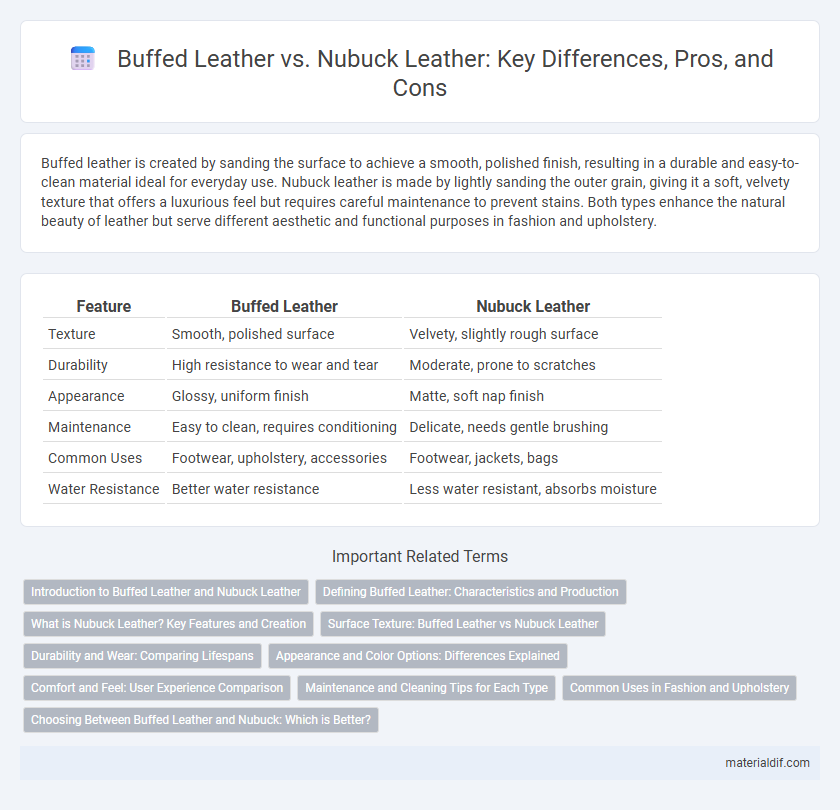Buffed leather is created by sanding the surface to achieve a smooth, polished finish, resulting in a durable and easy-to-clean material ideal for everyday use. Nubuck leather is made by lightly sanding the outer grain, giving it a soft, velvety texture that offers a luxurious feel but requires careful maintenance to prevent stains. Both types enhance the natural beauty of leather but serve different aesthetic and functional purposes in fashion and upholstery.
Table of Comparison
| Feature | Buffed Leather | Nubuck Leather |
|---|---|---|
| Texture | Smooth, polished surface | Velvety, slightly rough surface |
| Durability | High resistance to wear and tear | Moderate, prone to scratches |
| Appearance | Glossy, uniform finish | Matte, soft nap finish |
| Maintenance | Easy to clean, requires conditioning | Delicate, needs gentle brushing |
| Common Uses | Footwear, upholstery, accessories | Footwear, jackets, bags |
| Water Resistance | Better water resistance | Less water resistant, absorbs moisture |
Introduction to Buffed Leather and Nubuck Leather
Buffed leather is crafted by sanding the outer surface of full-grain leather, resulting in a smooth, uniform texture that enhances durability and allows for easy maintenance. Nubuck leather is produced by sanding the inner side of the hide, creating a soft, velvety nap similar to suede but stronger and more resistant to wear. Both types are prized for their premium feel and are commonly used in luxury footwear and upholstery, with buffed leather offering a polished appearance and nubuck leather providing a matte, textured finish.
Defining Buffed Leather: Characteristics and Production
Buffed leather is characterized by a smooth, polished surface achieved through sanding or buffing the leather's grain side to remove imperfections and enhance softness. This process results in a durable, matte finish that is resistant to wear and scratches, making it ideal for high-quality leather goods. The production involves meticulous abrasion techniques that refine the leather texture without compromising its natural resilience.
What is Nubuck Leather? Key Features and Creation
Nubuck leather is a type of top-grain leather that has been finely sanded or buffed on the grain side to create a soft, velvety surface with a slight nap. Its key features include a durable yet breathable texture, subtle color variations, and a matte finish that distinguishes it from glossy leathers. The creation process involves carefully sanding the outer layer of high-quality hides, which enhances the leather's natural toughness while providing a plush feel often used in premium footwear and accessories.
Surface Texture: Buffed Leather vs Nubuck Leather
Buffed leather features a smooth, polished surface achieved by buffing the top grain, resulting in a glossy and uniform appearance. Nubuck leather has a soft, velvety texture created by sanding the outer layer of the hide, giving it a matte finish with a slight nap. The key difference lies in buffed leather's sleek sheen compared to nubuck's delicate, suede-like feel.
Durability and Wear: Comparing Lifespans
Buffed leather offers enhanced durability due to its thicker finish and resistance to scratches, making it ideal for heavy-use items that require long-lasting wear. Nubuck leather, while softer and more porous, tends to show signs of wear faster and requires more maintenance to preserve its appearance over time. The lifespan of buffed leather typically exceeds that of nubuck leather, especially in environments where abrasion and exposure to elements are frequent.
Appearance and Color Options: Differences Explained
Buffed leather features a smooth, polished surface with a consistent color finish, offering rich, deep hues that enhance the leather's natural grain. Nubuck leather showcases a soft, velvety texture created by sanding the outer layer, resulting in a matte appearance with slightly lighter and muted color options. The unique finishing processes lead buffed leather to appear more glossy and uniform, while nubuck's brushed surface provides subtle variations in shade and a more natural, worn-in look.
Comfort and Feel: User Experience Comparison
Buffed leather features a smooth, polished surface that offers a firm yet pliable feel, making it comfortable for extended wear by reducing friction against the skin. Nubuck leather, sanded on the outer side to create a soft, velvety texture, provides a plush, breathable feel that enhances comfort in warmer conditions. Users often prefer nubuck for its luxurious softness and supple touch, while buffed leather is favored for durability combined with a break-in comfort.
Maintenance and Cleaning Tips for Each Type
Buffed leather requires regular conditioning to maintain its smooth finish and prevent cracking, with cleaning done using a damp cloth and mild soap to remove dirt without stripping oils. Nubuck leather, characterized by its velvety surface, demands gentle brushing with a soft suede brush to lift dirt and restore texture, avoiding water exposure to prevent staining. Both types benefit from using specialized leather protectants to enhance durability and resist moisture.
Common Uses in Fashion and Upholstery
Buffed leather, known for its smooth and polished surface, is commonly used in fashion items like handbags, shoes, and jackets due to its durability and sleek appearance. Nubuck leather, featuring a soft, velvety texture from sanding the outer layer, is popular in high-end upholstery and casual footwear, offering a luxurious yet rugged look. Both types find widespread applications in furniture design, with buffed leather favored for modern, easy-to-clean pieces and nubuck for creating warm, tactile environments.
Choosing Between Buffed Leather and Nubuck: Which is Better?
Buffed leather features a smooth, polished surface achieved by sanding the grain side, offering durability and ease of maintenance, making it ideal for high-traffic items like shoes and bags. Nubuck leather is sanded on the outer side to create a soft, velvety texture, prized for its luxurious appearance but requiring careful protection against stains and moisture. Choosing between buffed leather and nubuck depends on the desired balance between toughness and aesthetic appeal, with buffed leather favoring resilience and nubuck catering to premium softness and style.
Buffed Leather vs Nubuck Leather Infographic

 materialdif.com
materialdif.com